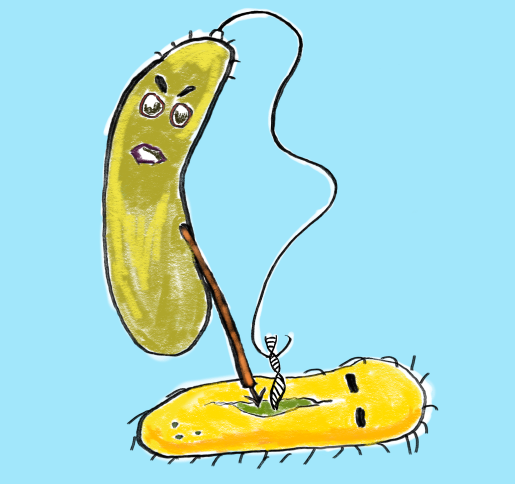Do bacteria steal data?

Information is also a valuable commodity for bacteria. However, microorganisms do not encode in bits and bytes, but write their data directly into their genetic material. The genetic data set of closely related bacteria sometimes varies greatly, and depending on the information content, this is crucial for life. This naturally makes unscrupulous: data is also stolen in the microcosm.
The genetic information of even closely related bacteria can be very different. Often the common genetic blueprint of a single species is less than 40% (we humans are genetically more than 99% similar). The bacterial blueprint contains a lot of information that only offers an advantage under certain conditions. One example of this is antibiotic resistance, which only becomes relevant for the microorganism when it is exposed to these deadly molecules. The exchange of such genetic data is therefore important. New genes can be acquired peacefully, for example through bacterial sex. However, microbes do not shy away from violence. An example of this is the behaviour of the pathogen that causes the diarrhoeal disease cholera: Vibrio cholerae prefers to colonise the shells of crustaceans. The chitin it contains is an excellent nutrient. At the same time, however, the chitin also signals the presence of other bacteria with potentially interesting genetic material. In order to seize it, Vibrio cholerae rams a nanospear into the body of a potential victim bacterium and slits it open. Vibrio cholerae then assimilates the DNA released in this way and adds new information to its own blueprint. In addition, the DNA serves as food and as material for the construction of "microbial cities" - the biofilms.
Vibrio cholerae commits such predatory murder primarily on conspecifics. At first glance, this may seem surprising, as the bacterial species appears to decimate itself through this behaviour. In fact, however, it deliberately favours the unhindered reproduction of certain members of the strain that recognise each other on the basis of shared molecular characteristics and therefore do not kill each other. The data theft is preferably carried out on those Vibrio cholerae whose blueprint is particularly different from their own. In addition, genes of conspecifics can be decoded very easily, which facilitates the expression of new traits that are potentially necessary for survival.
Read more:
© Text: Jürgen Lassak / VAAM, juergen.lassak[at]lmu.de, Use according to CC 4.0
© Figure: Christine Neupert, Nutzung gemäß CC 4.0

